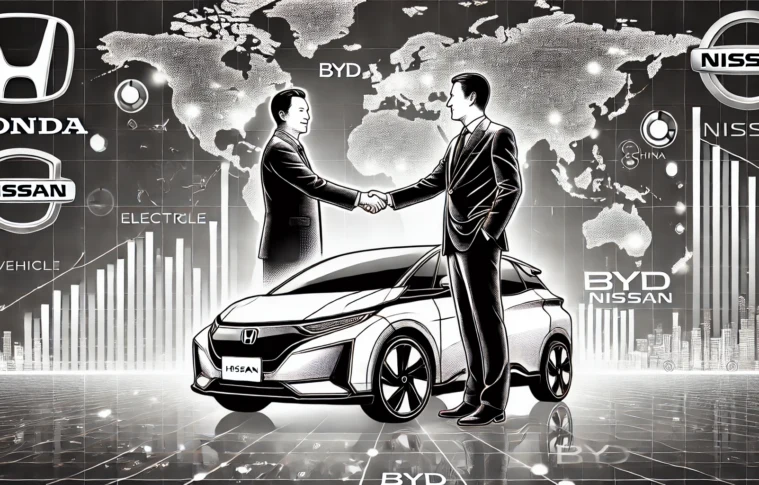Introduction: A Shifting Landscape in the Global Automotive Industry
The global automotive industry is in the midst of a profound transformation, driven by an accelerating shift towards electric vehicles (EVs) and the intensifying competition in this burgeoning sector. At the heart of this transition lies China’s BYD (Build Your Dreams), which has rapidly ascended to the top of the global EV market, leaving traditional automakers scrambling to keep pace. In response to this growing challenge, Japan’s two automotive giants, Honda and Nissan, have announced a landmark merger deal that is expected to be a game-changer in the race against BYD and other Chinese EV manufacturers.
This potential merger, one of the most significant in the automotive industry in recent years, could reshape the competitive dynamics of the global EV market. For both Honda and Nissan, joining forces presents a unique opportunity to combine resources, technology, and expertise to accelerate their electric vehicle production, enhance R&D capabilities, and secure a stronger foothold in key markets worldwide. But the deal’s broader implications may go far beyond Japan’s shores, directly influencing the strategic positioning of automakers in the face of an emerging Chinese auto dominance.
In this article, we delve into the details of the proposed Honda-Nissan merger, examining the reasons behind the move, the potential synergies it brings, and how it may help the Japanese automakers combat the growing threat from BYD, which has emerged as a formidable force in both the Chinese and global electric vehicle markets.
The Rising Dominance of BYD in the Global EV Market
In recent years, BYD has demonstrated an unprecedented growth trajectory, cementing its status as a global leader in electric mobility. Founded in 1995, BYD initially made a name for itself in the battery and energy storage sector before pivoting to automobiles. The company’s foray into electric vehicles began in the mid-2000s, and today, BYD has become a dominant player not only in China but also across international markets.
Key factors contributing to BYD’s rapid rise:
- Massive Scale and Production Capacity: With extensive manufacturing facilities and an integrated supply chain, BYD has rapidly scaled up its EV production to meet growing demand, producing both electric passenger cars and commercial vehicles such as buses and trucks.
- Cost Leadership: By producing batteries in-house and leveraging economies of scale, BYD is able to offer competitive prices, making EVs more affordable for consumers, a critical factor in driving adoption.
- Government Support: Chinese government policies favoring domestic electric vehicle manufacturers, including subsidies, tax incentives, and infrastructure development, have played a crucial role in BYD’s growth.
- Global Expansion: Beyond China, BYD has successfully expanded its footprint in markets such as Europe, Latin America, and even the United States, where it is pushing hard to capture market share.
- Technological Advancements: BYD’s continuous investments in battery technology, including the development of its proprietary “Blade Battery,” which is more energy-dense, safer, and cheaper to produce than many competitor offerings, has positioned the company as a technological leader in the EV sector.
The Honda-Nissan Merger: A Response to a Changing Market
Given BYD’s rapid growth and its growing presence in international markets, Japanese automakers like Honda and Nissan have found themselves under increasing pressure. The two companies, once giants in their own right, have faced challenges in keeping up with the electrification trend, both in terms of vehicle production and technological innovation.
Honda’s Electric Vehicle Strategy: Honda has long been recognized for its commitment to innovation, but its EV offerings have struggled to match the scale of rivals. The company’s early attempts at electric vehicles, such as the Honda Clarity and the Honda e, have not achieved the market success it hoped for. However, Honda has made strides in recent years with its partnership with General Motors to develop electric vehicles using GM’s Ultium platform, as well as its ambitious plans to launch a series of EVs by 2030.
Nissan’s Electric Vehicle Push: Nissan, one of the pioneers of the electric vehicle movement with the launch of the Nissan Leaf in 2010, has been at the forefront of global EV adoption. However, in recent years, it has faced increasing competition, particularly from Chinese and American manufacturers. While Nissan continues to lead in some markets, its EV portfolio has lagged in terms of innovation and battery technology compared to companies like Tesla and BYD.
Strategic Necessity for Merger: In response to these challenges, both Honda and Nissan have realized that surviving in an increasingly electric future requires a significant restructuring of their operations, technology development, and market strategies. A merger between the two automakers would allow them to pool resources, reduce operational redundancies, and enhance their technological capabilities.
Synergies and Benefits of the Merger
The proposed merger between Honda and Nissan is poised to unlock a range of synergies that would position the combined entity to better compete with BYD and other leading electric vehicle manufacturers.
1. Economies of Scale: A merger would allow the companies to significantly reduce costs by consolidating manufacturing operations, pooling research and development resources, and optimizing supply chains. This would be especially important in a market where cost control and efficiency are critical to maintaining profitability while scaling EV production.
2. Combined R&D Resources: Honda and Nissan have long been known for their engineering prowess, but in the rapidly evolving electric vehicle sector, the ability to innovate is paramount. By joining forces, the two companies can share cutting-edge EV technologies, such as next-generation battery solutions, autonomous driving systems, and electric powertrains. This collaboration could help the merged entity achieve technological breakthroughs that allow it to compete head-to-head with BYD in terms of range, charging time, and overall vehicle performance.
3. Expanded Global Reach: While both Honda and Nissan have a significant presence in key markets such as the U.S., Europe, and Asia, a merger would provide them with a more comprehensive global footprint, allowing for greater market penetration. BYD, on the other hand, is already making inroads in Europe, Latin America, and Africa, and the combined force of Honda and Nissan would help them fend off the Chinese company’s push into these regions.
4. Strengthened Supply Chain and Partnerships: Both Honda and Nissan have established extensive supplier networks, and pooling their supply chains would create greater bargaining power with parts suppliers, leading to potential cost reductions. Additionally, they could strengthen their relationships with battery producers, an area where BYD already has an advantage due to its in-house production capabilities.
5. Shared Infrastructure Investments: EV infrastructure, particularly charging networks, is a key factor in the adoption of electric vehicles. A merged Honda-Nissan entity could collaborate on the development of a more expansive and accessible charging network, addressing one of the major barriers to EV adoption. This could give the combined company an edge over BYD, which is still developing its infrastructure in various regions.
The Competitive Threat from BYD: Why Honda and Nissan Need to Act Now
While Honda and Nissan may have been late to the electric vehicle race, they are not without options. BYD’s rise has sent shockwaves through the global automotive industry, and both Honda and Nissan recognize the importance of accelerating their transition to electric mobility. The Chinese manufacturer’s ability to leverage scale, technology, and cost leadership has given it an edge, particularly in emerging markets where price sensitivity is high.
BYD’s aggressive pricing strategy, coupled with its advanced technology, puts considerable pressure on traditional automakers. The company’s ability to produce high-quality EVs at competitive prices is making it increasingly difficult for companies like Honda and Nissan to maintain market share, especially in Asia and Europe. The merged entity would need to act quickly and decisively to close the technological and market gap, particularly in the areas of battery development, autonomous driving, and manufacturing efficiency.
Conclusion: A Bold Step Towards Electrification
The proposed merger between Honda and Nissan is more than just a strategic business decision; it is a bold step towards redefining the future of mobility. In a rapidly changing automotive landscape dominated by electric vehicles, the Japanese automakers recognize that collaboration is key to survival. By combining their strengths in engineering, manufacturing, and innovation, Honda and Nissan are positioning themselves to not only compete with BYD but also to become a dominant force in the global EV market.
However, the road ahead will be challenging. BYD’s aggressive expansion plans, combined with its cost leadership and technological edge, mean that the merged Honda-Nissan entity will have to act swiftly to realize the full potential of their alliance. The battle for EV supremacy is far from over, but with the right strategy and execution, Honda and Nissan may just have the tools they need to turn the tide in their favor.
Market Performance of Key Competitors in the EV Sector:
| Company | EV Market Share (2024) | Key EV Models | Global Expansion | 2025 EV Launch Plans |
|---|---|---|---|---|
| BYD | 25% | BYD Seal, Tang EV, Atto 3 | Europe, Latin America, China | Launch of 5 new models |
| Honda | 5% | Honda e, Prologue EV | North America, Japan, Europe | 3 new models by 2026 |
| Nissan | 6% | Nissan Leaf, Ariya EV | Europe, U.S., Asia | Electric SUV and sedan lineup |
| Tesla | 18% | Model 3, Model Y, Cybertruck | Global, particularly U.S. | Cybertruck launch, Semi Truck |
| Volkswagen | 10% | ID.4, ID.3, ID. Buzz | Europe, U.S., China | ID. Buzz EVs in North America |



